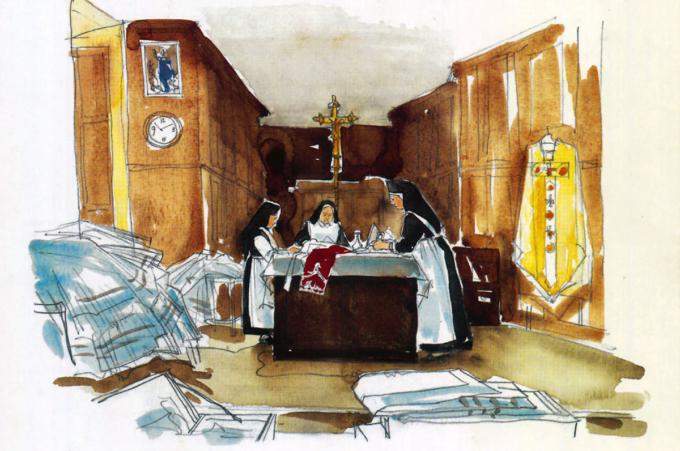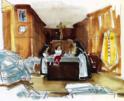
Faith
They come to life outside of the celebration of Mass or other liturgies, more intensely prior to and after the liturgies. And almost all of the effect of their work is unseen by us.

O'Grady
Off to the right or left (sometimes both) of your parish church's sanctuary are rooms called sacristies. In an interesting twist, the older the church, the more likely the smaller the sacristy. In older churches, sacristy spaces are rarely in any proportion to the size of the church. And most readers may never have been into one of them.
Newer churches often have several spaces that previously were served by one. There may be a servers' sacristy, a work sacristy, a vesting sacristy, and a storage sacristy. And they may be in different locales in the church other than abutting the sanctuary.
Designed as places for the storage, cleaning, and general management of everything related to the sanctuary, these areas of the church are usually served by either an individual or a team -- overwhelmingly women -- who take care of making sure that the liturgy is supplied and supported with everything needed for its proper and appropriate and noble celebration.
An historical aside: When most readers were growing up, you never saw anyone except priests and altar servers entering those precincts. But there were individuals and teams of women -- overwhelmingly religious women assigned to the parish who had additional responsibilities in the sacristies beyond their school and usually religious education classes. Those extra responsibilities, for us, were chores; for the sisters, they were charges. They were really ministries, but the word had not seeped into those precincts yet.
They come to life outside of the celebration of Mass or other liturgies, more intensely prior to and after the liturgies. And almost all of the effect of their work is unseen by us.
A sacristan must be familiar with all the details of the celebration of Mass, but also of other sacraments and liturgies commonly celebrated in a parish church, e.g., baptisms, weddings, and funerals. If one is a sacristan in a cathedral -- well, I'd need at least three columns to tell you what they must do.
Here are some items that are the concern of sacristans.
Sacred vessels -- chalices, patens, ciboria; not necessarily sacred but needed pitchers and bowls; cruets for wine and water.
Vesture -- chasuble and stoles for priests; dalmatics and stoles for deacons; albs for other ministers; cassocks and surplices for servers, if they do not wear albs.
Altar vesture -- altar cloths, corporals, purificators, hand towels.
Liturgical books -- Missal, Book of the Gospels, lectionaries, hymnals, books for various rites both of sacraments and sacramentals and devotions.
Candles -- usually of various sizes, but always wax, which creates more work for them but, as with all things liturgical, "there's nothing like the real thing."
Incense -- and the thurible and charcoals needed to use it, and the little vessel that holds the incense called a boat.
Audio or sound system -- they don't need to be technologically trained but should be familiar with the system's basic functioning and whether batteries will be needed for portable microphones.
Geography -- not of the parking lot but of the sanctuary. The altar, ambo, presidential chair, credence table, table for hosts and wine for presentation of gifts, and other appointments.
They are usually responsible for ensuring adequate hosts and wine -- with a particular eye if there is to be Communion under Both Kinds -- are set for Mass.
Sacristans need also to be aware of the church's calendar. Usually, every sacristy will have an ordo readily available so that the sacristan will know the "color of the day" and which page to mark in the Missal and Lectionary. Often, there is an additional book created by the parish for its needs and legitimate options. They used to be called a "customary" because they detailed the customs of this parish, chapel, or religious order's house.
There are seasons of the church's life, each with its particular "flavor." The five seasons are Advent, Christmas, Lent, Easter, and Ordinary Time. Mingled into those seasons is the calendar of the saints, and local parish liturgies, e.g., the above mentioned, baptisms, etc.
A sacristan will tell you this list is, as they say, "illustrative and not exhaustive." There's a lot more involved!
Among those things would be the care of the sanctuary, its cleanliness and proper order. Likewise, the care of vesture, especially its cleanliness and repair as needed, and, if the time comes, the replacement.
The care and cleansing of the vessels and linens is an almost daily responsibility, not to mention ensuring that the supplies of many of the items mentioned above are in good order and available.
And the sacristan's work is mostly unseen and too often unheralded.
If you can ferret out a sacristan, thank them for their ministry of making our liturgy simple and beautiful.
For further information about this ministry: "Guide for Sacristans, Third Edition" by Corinna Laughlin and Paul Turner (2021, Liturgical Training Publications), and "The Sacristy Manual, Second Edition" (2011, Liturgical Training Publications), and, lastly, a sample parish guide or "customary" from the St. Teresa of Avila Catholic Student Center at Valparaiso University available at: www.saintt.com/documents/2017/8/SacristanguidelinesFINAL.pdf.
Comments
Comments Policy
Recent articles in the Faith & Family section
-
Help!Jaymie Stuart Wolfe
-
SacristansFather Robert M. O'Grady
-
Join Our Societies: Be a Game Changer for the MissionsMaureen Crowley Heil
-
Solemnity of the Assumption of the Blessed Virgin MaryScott Hahn
-
The power of silence and the problem of sound in adorationDr. R. Jared Staudt


















